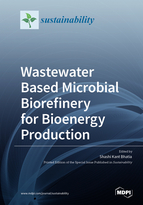Wastewater Based Microbial Biorefinery for Bioenergy Production
A special issue of Sustainability (ISSN 2071-1050). This special issue belongs to the section "Energy Sustainability".
Deadline for manuscript submissions: closed (15 June 2021) | Viewed by 44621
Special Issue Editor
Interests: biocatalysis and enzyme engineering; biofuel; biomaterial; biochemical engineering; antibiotics; metabolic engineering; glycosylation; bioencapsulation; mutagenesis; protein purification; molecular biology
Special Issues, Collections and Topics in MDPI journals
Special Issue Information
Dear Colleagues,
A rapid growth in various industries and domestic activities is resulting in a huge amount of wastewater. Various types of wastewater, such as textile, municipal, dairy, pharmaceutical, swine, and aquaculture, etc., are produced regularly by respective industries. These wastewaters are rich in nutrient content and promote eutrophication in the ecosystem and pose a threat to flora and fauna. According to an estimate, eutrophication causes losses of almost 2 billion US dollars annually, affecting real estate and fishing activities. Traditionally, the main purpose of wastewater treatment is to protect downstream users from health risks. Treatment of wastewater is a costly process and recently resource recovery from wastewater and technology for the treatment wastewater have received more attention. The energy crisis is another issue as it is estimated that extensive use of fossil-based fuels such as petrol, natural gases, and coal is going to exhaust within the next 50 years. There is a need to search for new alternate renewable resources of energy to fulfill future energy demand. Microorganisms can be used to recover nutrients from wastewater and produce bioenergy (biodiesel, biohydrogen, bioelectricity, methane, etc.). A better understanding of the composition of various types of wastewater, reactor design, isolation, characterization, and metabolic engineering of microbes to improve the resource recovery process from wastewater can help to make wastewater-based biorefinery a reality.
This topic will include a series of research and review articles covering but not limited to the following issues:
- Analysis of wastewaters and utilization as a feedstock for microbial fermentation and energy production.
- Wastewater treatment process integration with other energy production technology.
- Microalgae-based nutrient recovery from wastewater and bioenergy production.
- Bioenergy production from recovered microbial biomass after wastewater treatment using dark fermentation, fermentation, and microbial fuel cell (MFC) technology.
Assoc. Pro Shashi Kant Bhatia
Guest Editor
Manuscript Submission Information
Manuscripts should be submitted online at www.mdpi.com by registering and logging in to this website. Once you are registered, click here to go to the submission form. Manuscripts can be submitted until the deadline. All submissions that pass pre-check are peer-reviewed. Accepted papers will be published continuously in the journal (as soon as accepted) and will be listed together on the special issue website. Research articles, review articles as well as short communications are invited. For planned papers, a title and short abstract (about 100 words) can be sent to the Editorial Office for announcement on this website.
Submitted manuscripts should not have been published previously, nor be under consideration for publication elsewhere (except conference proceedings papers). All manuscripts are thoroughly refereed through a single-blind peer-review process. A guide for authors and other relevant information for submission of manuscripts is available on the Instructions for Authors page. Sustainability is an international peer-reviewed open access semimonthly journal published by MDPI.
Please visit the Instructions for Authors page before submitting a manuscript. The Article Processing Charge (APC) for publication in this open access journal is 2400 CHF (Swiss Francs). Submitted papers should be well formatted and use good English. Authors may use MDPI's English editing service prior to publication or during author revisions.
Keywords
- wastewater
- biodiesel
- biohydrogen
- methane
- microbial fuel cell






